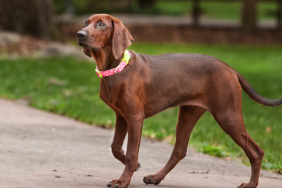Question: How do you make a Labradoodle invisible?
Answer: Look for them on a kennel club register.
Many of the dogs we see trotting along the street, such as Cavapoos or Goldendoodles, aren’t officially recognized by Kennel Clubs.
Despite being hugely popular and instantly recognizable, dogs such as the Labradoodle are hybrids and can’t be registered with national kennel clubs and therefore don’t officially “exist.” Although they play, eat, and poop just like a real dog.
But this doesn’t just apply to designer dogs. For example, the Bull Arab is a popular breed in Australia, but they have not been recognized by the Australian Kennel Club — or any other official national register.
Why Bother With Breeds At All?

Kennel clubs register breeds to maintain uniformity and protect the breed standard — that is, their appearance and character traits — down the generations. Indeed, dog breeds were first officially recognized back in 19th century England for just this purpose.
In the 1860s, as now, people were obsessed with their dogs. They loved them so much they wanted to show them off in public at dog shows. These events were competitive, with prizes awarded to the best dogs.
But when a group of dogs had similar physical traits, how could you decide which was best? The answer was a checklist of the most desirable traits for the breed: hence the breed standard was born.
The knock-on effect was to increase uniformity within a group, with each breed distinct and identifiable. This also meant that, when breeding together dogs matching this breed standard, the next generation would “breed true” or breed-pure to the parents’ line, which is where the term “purebred” comes from.
Of course, someone needed to write and check the breed standards, which meant a governing body needed to be set up to oversee fair play. That’s why kennel clubs came into existence.
The Benefits Of Official Recognition
Does it matter if a rare breed or a hybrid such as the Cavapoo or Malshi receives official recognition?
Actually, there are benefits to being on a kennel club’s approved list. These include:
- Protection for endangered breeds: Breed enthusiasts can work together to safeguard the numbers of dogs belonging to rare breeds.
- Protection for breed purity: With a database of purebred stock on file, this helps breeders select stud animals that are pedigreed but not closely related. This promotes genetic diversity whilst keeping the dogs purebred.
- Promotion of good breed health: With a register of breeders working together, breed-related health problems can be identified, tested for, and eventually eradicated.
- Promotion of breed welfare: Breeders wishing to register must work to achieve approved standards, which benefits animal welfare.
- Increased breed profile: A purebred dog can take part in dog shows and potentially raise the breed’s profile and popularity.
How Do Breeds Make The Cut?

According to US statistics, only two-thirds of “known” dog breeds are recognized by the American Kennel Club. Why is this?
Hurdles To Jump
Registering a breed isn’t simply a matter of filling out forms. It’s complicated and takes time — at least 40 years in most cases.
Think of the registration process like an agility course, with many obstacles that need to be cleared before reaching the finish line. This can be complex. Let’s take a look at how the American Kennel Club (AKC) tackles this issue.
The AKC’s requirements to register a new breed include:
- There must be at least 150 of the dogs alive.
- There’s an active breed association promoting the dogs.
- There’s a clear description or breed standard for the dogs.
- At least three generations of pedigree are documented in a studbook.
- The breed is registered on a legitimate foreign or domestic registry.
- The dogs are of a reliable temperament.
- The breed has been in existence for at least 40 years.
The ‘Chicken & Egg’ Conundrum
Okay, so if a breed isn’t kennel club registered, how can it be on a ‘legitimate domestic registry’?
This is where other organizations come in, such as the American Kennel Club’s Foundation Stock Service. The FSS is a staging post whereby wannabe pedigree dogs can register a studbook as a means of establishing a lineage.
Making The Cut
Going back to the example of the Bull Arab and using the American Kennel Club model, let’s see how things stack up with regards to getting registered.
A tick in the box for the Bull Arab breed association, because the Australian Bullarab Breed Association (ABBA) represents and promotes these dogs, and has created a clear breed standard.
The breed was developed in the 1970s, which puts them on schedule for being in existence for 40 years, provided they have been breeding-true for the duration of that time.
Perhaps ABBA can tell us how many dogs are in Australia, but if it’s less than 150, no matter how good the paperwork and records, the application may grind to a halt.
Character Controversy
Now here’s an interesting thought. To be registered, a breed needs to be of good character. This is a practical requirement because a judge can’t properly assess an aggressive dog’s conformation without them getting injured.
Thus, certain breeds that were created as working and guarding dogs who don’t tolerate strangers may never be registered. Their unpredictable temperament might be fine for a working dog, but it’s not appropriate in the show ring.
Being of good character makes excellent sense for pet dogs. But it does mean that certain breeds will be self-excluding from officialdom because fierceness is part of their role or job.
But just like the Cavapoos or Labradoodles, it doesn’t mean they don’t exist. Takes some thinking about, doesn’t it?
Registering A New Breed 101
If a new kind of dog can tick all these boxes, they can be registered as a new dog breed.
- An active breed society
- More than 150 dogs in existence
- Puppies have a predictable appearance for at least three generations
- The breed is logged on a legitimate registry
- The dogs have a good temperament
- A kennel club agrees to register them
Now it makes sense that in the US, for example, less than half of known dog breeds are officially registered with the American Kennel Club.
Food for thought indeed: this process requires commitment on the part of pet parents and breeders, which is good for dogs. But it could also mean swathes of unrecognized breeds go unregulated, which is bad for dogs.
Hmmm — a tricky path to tread.
Do you think all breeds should have strict requirements to be registered with kennel clubs? Do you think we should stop worrying about breed at all? Let us know in the comments below!









